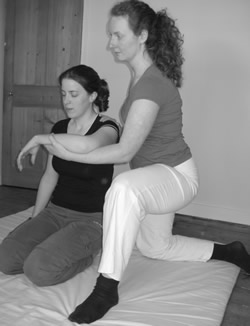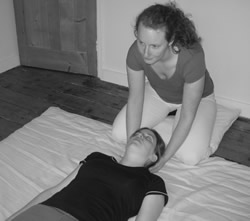Positive Health Online
Your Country

Remove bookmark
Shiatsu for Health and Wellbeing
by Cheryl L Jenkins(more info)
listed in shiatsu, originally published in issue 161 - August 2009
The very first long-term study across Austria, Spain and the UK shows concrete evidence for the health benefits of Shiatsu.[1,2] Shiatsu receivers had significant improvements in the severity of their symptoms which were maintained throughout the six-month study. At the end of the study, clients had adopted a more relaxed, healthier, and balanced approach to life.

Shiatsu has been practised in some form in Japan for many centuries and in Europe for over thirty years - see Box 1 for a description of Shiatsu. Until now, there have been no objective assessments of the effects of Shiatsu. These results are timely, as many are calling for greater regulation and more research for a number of complementary therapies across Europe.[3,4] One of the key challenges for Shiatsu research has always been in study design. It is difficult to design a study that includes the concept of holism and does not disrupt the client-practitioner relationship which is at the foundation of many complementary therapies.[5]

A research study carried out by the University of Leeds and sponsored by the European Shiatsu Federation (ESF) looked to resolve this issue and study Shiatsu as it is actually practised. The research was carried out in two phases: phase one explored the effects that Shiatsu receivers commonly experienced and phase two explored these effects in greater detail looking at how they might change over a six-month period.
Phase one: An Exploratory Study
Phase one of the study assessed both client and practitioner perspectives on common, immediate and longer term effects of Shiatsu - see Box 2 for further details.[2] During this study the initial effect of Shiatsu on symptoms, relaxation, sleeping, posture and experiences of the body were described by participants to give an overview of common responses. The results of this exploratory study were discussed with a wider group of Shiatsu practitioners to allow questions to be refined. These questions were then used as the basis for the design of questionnaires given to Shiatsu clients in phase two of the project.|
Box 1 – What is Shiatsu?
Shiatsu is a natural therapy that was developed in Japan where it has been used for centuries to promote health and alleviate illness. Its foundations are based on Traditional Chinese Medicine, but it has also been influenced by western knowledge. |
|
Box 2 – Phase One: An Exploratory Study[2]
|
Phase Two: A Cross-European Study
This phase of the research was designed to have minimal impact on both the Shiatsu treatment and the client-practitioner relationship.[1] Practitioners taking part in the study were not aware which of their clients participated. Clients' reported their actual perceptions and experiences of receiving Shiatsu by completing a series of questionnaires following treatment over a six-month period - see Box 3 for more details of the study design. This ensured that the study evaluated Shiatsu as it is actually practised, and as a result, the study contains many valuable insights for practitioners. A Typical Shiatsu Client
Based on the findings of the study, a typical Shiatsu client is a woman in her forties who is in paid employment and considers herself to be in good health. She pays for her own treatment and will have an average of two to three sessions over the course of three months. At the first session, most clients tried Shiatsu out of curiosity, and thereafter they continued to have Shiatsu to maintain or improve their health. The top three groups of symptoms that were given as a reason for treatment were: problems with muscles, joints, or body structure; tension and stress; and low energy or fatigue.The top seven on the clients' list of hopes or expectations from Shiatsu were: energy work, self-enhancement, relaxation and stress reduction, relief from symptoms, alleviation of symptoms of specific conditions, emotional help and support, and enhancing awareness of body and mind.
|
Box 3 – Phase Two: A Cross-European Study[1]
|
Client-Practitioner Relationship
One key result that is evident from this research is the overwhelmingly positive quality of the interaction between the client and the practitioner. Clients described Shiatsu practitioners as trustworthy, skilful and warm. Clients also left the Shiatsu session feeling that they'd been listened to and accepted. About 74% of clients received advice or recommendations from their Shiatsu practitioner following their first session. At six months, between 77% and 80% of clients had made changes to their lifestyle as a result of suggestions made by the practitioner during Shiatsu sessions. 
The Effects of Shiatsu
More than three quarters of Shiatsu clients that took part in the study said that they were more relaxed, more balanced, more energized and were able to sleep better as a result of the treatments. There were also improvements in, and general confidence about, their health. Many clients had improvements in problems with muscles and joints, including back pain and postural misalignments. Some clients also described a difference in the way that they use their body as a result of Shiatsu treatment and a change in the way that they experienced their body. Clients had fewer symptoms of stress and tension and felt more able to cope. Over a third of clients described changes in their body-mind awareness and their confidence and levels of resolve. Overall, they felt that their psychological wellbeing had improved too. Shiatsu clients were also more motivated to make positive lifestyle changes, particularly with regard to diet and exercise. Changes in clients' use of healthcare were also evident by a reduction in use of conventional medicine and medication over the six month period. Although this study was not designed to assess the potential economic value of receiving Shiatsu treatments, these results suggests that it could help to reduce the costs of healthcare and medication for some patients.
Transitional Effects of Shiatsu
One of the key findings from both studies[1,2] was that of the healing response. This response was understood by both the client and practitioner to be an integral part of the healing process. When this response is experienced by clients it may be considered as negative or unexpected and may involve a short-term intensification of original symptoms. This is viewed as evidence of a response to treatment that occurs as part of the normal and natural responses that clients might have following treatment. Quite often this response resolves within 24 to 48 hours of the session and therefore these effects are considered to be transitional. Across the three countries involved in the study between 12% and 24% of clients reported these transitional effects following a Shiatsu session. But, none of those clients who reported these effects stopped having Shiatsu treatment. A small number (1.4%) had responses that were potentially adverse effects - effects that may represent a risk to client safety - which is comparable to findings from acupuncture studies.[6] These findings highlight how important it is for practitioners to educate their clients about any potential healing response and the need for post-treatment support. Practitioners can and should advise their clients about the forms that this healing response might take and what to do if this should occur, for example drinking extra water or sleeping when feeling tired. The European Shiatsu Federation has also produced a leaflet on transitional effects that practitioners can give to their clients following their first session. Shiatsu Improves Health and Wellbeing
The results from these studies show that Shiatsu has great potential for not only improving and maintaining client health, but also for improving the quality of life for many people. The fact that clients were more able to make changes in their life also highlights that they were empowered and supported to take control, and change direction where it was appropriate. The results also suggest that the reduced use of healthcare and medication has potential implications for reducing healthcare costs and loss of work time due to illness. As is often the case with research, it is clear that more research is needed to fully evaluate the impact that Shiatsu can have on health and wellbeing, but this is a very strong foundation on which to build. References
1. Long AF. The effectiveness of shiatsu: findings from a cross-European, prospective observational study. J Altern Complement Med 14(8):921-930. 2008.2. Long AF and Mackay HC. The effects of shiatsu: findings from a two-country exploratory study. J Altern Complement Med 9(4):539-547. 2003.
3. European Parliament. The Collins Report, Resolution on the Status of Non-conventional Medicine. European Parliament, Strasbourg. 1997.
4. European Union. Decision No 1982/2006/EC of the European Parliament and the Council on 18th December converning the Seventh Framework of Programme of the European Community for research, technological development and demonstration activities (2007-2013). Official Journal of the European Union L412:1-41. 2006.
5. Mason S et al. Evaluating complementary medicine: methodological challenges of randomised controlled trials. BMJ 325(7368):832-834. 2002.
6. Long AF et al. A typology of negative responses: a case study of shiatsu. Complement Ther Med 17(3):168-175. 2009.
Further Information
For further information visit the ESF (European Shiatsu Federation) and Shiatsu Society websites: www.shiatsu-esf.org/ and www.shiatsusociety.org Acknowledgements
The European Shiatsu Federation sponsored this study which was only possible thanks to the donations from many countries across Europe and collaboration with the national Shiatsu associations of the countries that participated. Many thanks also to Seamus Connolly, project coordinator at the ESF (European Shiatsu Federation), and Professor Andrew Long and his research team at the University of Leeds.Comments:
-
No Article Comments available